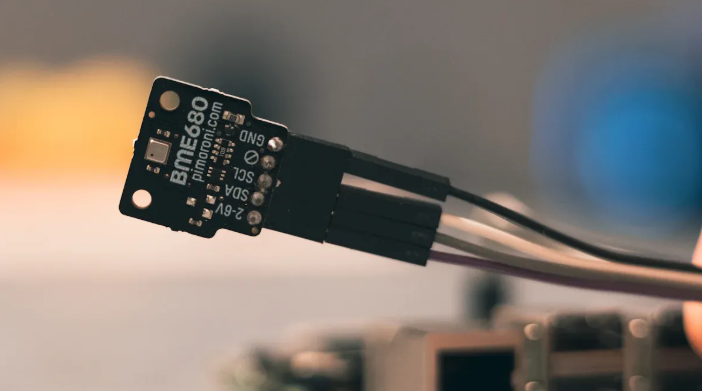Understanding Types of Sensors and Surge Protection Devices
You use sensors and varistors every day, even if you do not notice. Sensors help you check things like temperature, motion, or pressure. These make smart devices work better. Surge protection devices, like a varistor, protect your electronics from sudden voltage jumps. These jumps can break your devices. For example, temperature sensors help keep your house at a good temperature. Surge protectors keep data centers and homes safe from power surges.
Sensors and Varistors Overview
What Are Sensors?
You use sensors all the time, even if you do not notice them. A sensor is a tool that finds changes in the world around it. It can tell if things like temperature, light, or motion change. When a sensor finds something new, it sends a message to another part. This helps machines know what is going on.
Sensors are important in smart devices and the Internet of Things. Some new sensors do not need batteries. They get energy from things around them. This makes devices smaller and better. You can see these sensors in health trackers, smart homes, and bridges for safety.
1、Sensors let devices learn about what is near them.
2、Wireless sensors help make gadgets smaller and smarter.
3、Energy-harvesting sensors make their own power, so they are good for IoT.
What Are Varistors?
A varistor is a part that keeps electronic circuits safe from sudden high voltage. When the voltage goes up too much, the varistor changes how it works. This stops the extra voltage from hurting your things. You can find varistors in surge protectors and power strips.
Varistors do more than stop surges. They also help stop sparks in motors and machines. When a motor shuts off, it can make a spark that could hurt the circuit. The varistor takes in this spark and keeps things safe.
Varistors change how they work when voltage gets high, helping control power.
They take in sparks from motors, stopping harm before it happens.
When there is a surge, varistors hold back the voltage and might make a fuse blow, which keeps the rest safe. Sensors and varistors are used together in many places. Sensors find changes, and varistors keep things safe from surges. You can see both in smart homes, factories, and many IoT devices.
Sensor Types

Image Source: unsplash
Classification
Sensors can be sorted in different ways. The main ways are by power source, output type, and what they measure.
Tip: Knowing how a sensor is grouped helps you pick the best one for your project.
Common Types
Temperature sensors: Used in food safety, medical tools, and factories.
Level sensors: Found in washing machines, cars, and factories to check liquid levels.
Pressure sensors: Used in car tires, pipelines, and hydraulic systems.
Vibration sensors: Help watch machines and find problems early.
Humidity sensors: Used in weather stations and smart homes.
There are also sensors like infrared, proximity, ultrasonic, force, and vision sensors. Each one helps you measure or find something different.
Key Features
Each sensor type has special things that make it good for certain jobs.
Sensitivity tells you how small a change the sensor can notice. For example, a blood pressure sensor may spot tiny changes in pressure.
Accuracy shows how close the sensor’s reading is to the real value.
Response time means how fast the sensor reacts to a change.
Note: Some sensors, like Hall effect sensors, work well for motion, level, and proximity jobs. Infrared sensors are great for flame detection and security. You can use different sensor types for the same job, like checking fuel levels, based on how exact you need the reading to be.
Selection Tips
When you pick a sensor, think about where and how you will use it.
1、Make sure the sensor can survive tough places like water, dust, or shock.
2、Check if it works in the temperatures you expect, like cold or hot weather.
3、Look at the size and shape to see if it fits your device or space.
4、Think about how long you need the sensor to work and how often it must send data.
Pro Tip: If you use a sensor outside, pick one with a strong case. For big areas, check if the sensor can send signals far enough. If you want to save power, choose a sensor that uses less energy.
You see sensors and varistors working together in many smart systems. Sensors help you collect data, while varistors keep your devices safe from power surges. When you know the types and features, you can make better choices for your projects.
Varistor Types
MOV and Others
There are different kinds of varistors in circuits. The most common one is the Metal Oxide Varistor, or MOV. MOVs use zinc oxide mixed with other metals like cobalt and manganese. Makers press these powders between two metal plates called electrodes. Inside, the metal grains make many diode junctions. These help the MOV react fast to voltage surges.
MOVs come in many shapes and sizes. You might see them as disks, blocks, or with wires for easy use. Another type is the Silicon Carbide Varistor, or SiCV. SiCVs use silicon carbide as their main material. They work well where very big surges can happen.
1、MOVs protect most electronics at home and in offices.
2、SiCVs are best for heavy-duty or factory use.
3、MOVs give quick protection from voltage spikes. SiCVs last longer and handle bigger surges, but they are a bit slower.
Selection Criteria
You need to check a few things when picking a varistor. The right one keeps your electronics safe and working longer.
Clamping Voltage (VC):The voltage where the varistor starts to protect. It should be high enough for normal use but low enough to stop spikes.
Surge Current Capacity:The biggest surge current the varistor can handle. It must be higher than any surge you expect.
Response Time:How fast the varistor reacts, usually in nanoseconds. Fast response is best for sensitive devices.
Energy Rating (Joules):How much energy the varistor can absorb in one surge. Match this to your system’s needs.
Capacitance and Impedance:Varistors add capacitance and impedance. Low-capacitance types work better for signal lines.
1、Always check the varistor’s ratings for your system.
2、Use low-capacitance varistors for fast data lines.
3、For risky places, pick varistors with higher surge ratings.
Tip: If you use varistors where surges happen a lot, check them often. Over time, they can wear out and stop working well.
Safety
Safety is important when you use varistors. International standards help you pick safe and reliable parts. These rules tell you how to use varistors in many devices.
1、Comprehensive Guidelines:Gives you clear rules for using varistors in electronics.
2、Up-to-Date Information:Includes the latest surge protection advances.
3、Detailed Specifications:Covers everything from materials to testing.
4、International Recognition:Accepted worldwide for global projects.
Varistors can break down over time. High voltage and heat make this happen faster. You may not notice a problem until the varistor fails. Regular checks help you find trouble early. The nonlinear coefficient shows how much a varistor has worn out. This helps you keep your protection strong.
Note: Sensors and varistors work together in many smart systems. Sensors collect data, and varistors keep electronics safe from surges.
Sensors and Varistors Applications
Everyday Uses
You find sensors and varistors in many things at home and in cars. These parts help your electronics stay safe and last longer. Here are some ways you use them every day: Surge protectors and power strips have varistors. They stop voltage spikes from hurting TVs, computers, and routers. Refrigerators and washing machines use varistors to protect control circuits from surges. Air conditioners have varistors to keep compressors and controls safe. Microwave ovens use varistors to protect the magnetron and control circuits. Televisions and audio systems use varistors to stop voltage spikes and keep your entertainment working.
In cars, varistors protect important systems. They keep engine control units safe from voltage spikes. Infotainment systems and lights also stay safe because of varistors. In electric vehicles, varistors protect high-voltage batteries and power electronics. Sensors in cars help with safety features like automatic braking and parking.
Tip: When you use smart home devices, sensors and varistors work together. They collect data and protect electronics from sudden power changes.
Industrial Uses
Factories and big buildings need sensors and varistors for safe and smooth work. You see many types of sensors in these places: Proximity sensors find objects without touching them. They help with moving materials and safety. Vision sensors check products on assembly lines for quality. Level sensors watch liquids and solids in tanks for automation. Temperature sensors control heat in food processing and machines. Pressure sensors keep pneumatic and hydraulic systems working right. Flow sensors manage gases and liquids in production. Force and torque sensors measure loads in robots. Gas and chemical sensors watch for dangerous gases to keep workers safe.
Varistors are important for protecting industrial equipment. They stop voltage spikes from hurting PLCs, drives, and other machines. MOVs are common here because they give strong overvoltage protection. If you use the right varistor, you stop system failures and keep your factory running.
Best Practice: Put varistors close to sensitive parts. Match their voltage rating to your circuit. Make sure you ground them well. Check varistors often for damage and keep them clean for best results.
You can make your system work better by doing these steps: 1. Check varistors often for signs of wear. 2. Test them to make sure they still work. 3. Watch the environment to avoid heat and moisture problems. 4. Keep records of all maintenance.
FAQ
What is the main job of a sensor?
A sensor helps you find changes in things like temperature, light, or motion. You use sensors to collect data and control devices in your home, car, or factory.
How does a varistor protect your electronics?
A varistor reacts fast when voltage gets too high. It absorbs extra energy and keeps your devices safe from damage. You often find varistors in surge protectors.
Can you use sensors and varistors together?
Yes! You use sensors to gather data and varistors to protect the electronics. Many smart systems, like home automation or factory machines, use both for safety and control.









